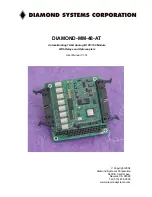
Inter-integrated circuit (I2C) interface
RM0365
813/1080
DocID025202 Rev 7
28.4.14 Wakeup from Stop mode on address match
This section is relevant only when Wakeup from Stop mode feature is supported. Please
refer to
Section 28.3: I2C implementation
.
The I2C is able to wakeup the MCU from Stop mode (APB clock is off), when it is
addressed. All addressing modes are supported.
Wakeup from Stop mode is enabled by setting the WUPEN bit in the I2C_CR1 register. The
HSI oscillator must be selected as the clock source for I2CCLK in order to allow wakeup
from Stop mode.
During Stop mode, the HSI is switched off. When a START is detected, the I2C interface
switches the HSI on, and stretches SCL low until HSI is woken up.
HSI is then used for the address reception.
In case of an address match, the I2C stretches SCL low during MCU wakeup time. The
stretch is released when ADDR flag is cleared by software, and the transfer goes on
normally.
If the address does not match, the HSI is switched off again and the MCU is not woken up.
Note:
If the I2C clock is the system clock, or if WUPEN = 0,
the HSI oscillator is not switched on
after a START is received.
Only an ADDR interrupt can wakeup the MCU. Therefore do not enter Stop mode when the
I2C is performing a transfer as a master, or as an addressed slave after the ADDR flag is
set. This can be managed by clearing SLEEPDEEP bit in the ADDR interrupt routine and
setting it again only after the STOPF flag is set.
Caution:
The digital filter is not compatible with the wakeup from Stop mode feature. If the DNF bit is
not equal to 0, setting the WUPEN bit has no effect.
Caution:
This feature is available only when the I2C clock source is the HSI oscillator.
Caution:
Clock stretching must be enabled (NOSTRETCH=0) to ensure proper operation of the
wakeup from Stop mode feature.
Caution:
If wakeup from Stop mode is disabled (WUPEN=0), the I2C peripheral must be disabled
before entering Stop mode (PE=0).
28.4.15 Error
conditions
The following are the error conditions which may cause communication to fail.
Bus error (BERR)
A bus error is detected when a START or a STOP condition is detected and is not located
after a multiple of 9 SCL clock pulses. A START or a STOP condition is detected when a
SDA edge occurs while SCL is high.
The bus error flag is set only if the I2C is involved in the transfer as master or addressed
slave (i.e not during the address phase in slave mode).
In case of a misplaced START or RESTART detection in slave mode, the I2C enters
address recognition state like for a correct START condition.
When a bus error is detected, the BERR flag is set in the I2C_ISR register, and an interrupt
is generated if the ERRIE bit is set in the I2C_CR1 register.
















































